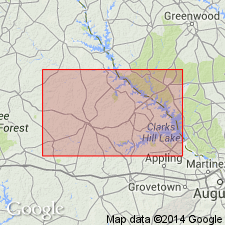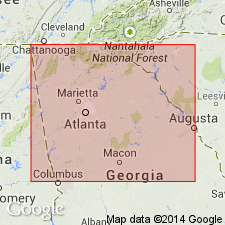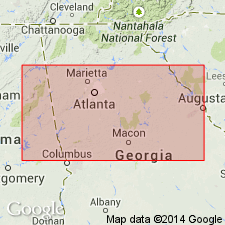
- Usage in publication:
-
- Little River series
- Modifications:
-
- Named
- Dominant lithology:
-
- Schist
- Amphibolite
- Pyroxenite
- AAPG geologic province:
-
- Piedmont-Blue Ridge province
Summary:
Little River series [first used by Crickmay on 1939 Geologic Map of Georgia] is described here as metamorphic series considered to be of volcanic and sedimentary origin. Consists of sericitic, chloritic, and amphibole-pyroxene rocks, all of which have been considerably silicified and otherwise altered. Subdivided into three general types: mica schist, garnet-mica schist, and weakly to nonschistose amphibole-pyroxene rocks. Age given as Paleozoic(?).
Source: GNU records (USGS DDS-6; Reston GNULEX).

- Usage in publication:
-
- Little River series
- Modifications:
-
- Areal extent
- AAPG geologic province:
-
- Piedmont-Blue Ridge province
Summary:
Little River series is a complex group of sedimentary, extrusive, and intrusive rocks of distinctly younger age than the surrounding more highly metamorphosed schists and gneisses of Carolina series. Of the metamorphic rocks of the State, this series alone may be Paleozoic, but its relationships to known Paleozoic slates further north (Quantico and Arvonia) are unknown. Biotite phyllite occurs in northern Wilkes Co. where series is intruded by Elberton granite.
Source: GNU records (USGS DDS-6; Reston GNULEX).

- Usage in publication:
-
- Little River Complex*
- Modifications:
-
- Revised
- AAPG geologic province:
-
- Piedmont-Blue Ridge province
Summary:
Little River Complex, revised from the Little River series of Crickmay (1952), extends from southern GA to southwest of the NC-VA state line. Consists of mildly metamorphosed volcanic, volcaniclastic, volcanic-epiclastic, and metamorphic rocks previously assigned to the Carolina slate, Belair, and Little River belts, and parts of the Raleigh, Kiokee, Charlotte, and Uchee belts. Was deposited in the Little River volcanic arc at the oceanward edge of an African microcontinent or the core of present-day Africa. Structurally overlies the Macon Complex (new name) and underlies the Northern Florida platform sequence, all three of the Little River thrust stack. Age is Late Proterozoic [author's late Precambrian] to Middle Cambrian based on radiometric ages and fossils.
Source: GNU records (USGS DDS-6; Reston GNULEX).
For more information, please contact Nancy Stamm, Geologic Names Committee Secretary.
Asterisk (*) indicates published by U.S. Geological Survey authors.
"No current usage" (†) implies that a name has been abandoned or has fallen into disuse. Former usage and, if known, replacement name given in parentheses ( ).
Slash (/) indicates name conflicts with nomenclatural guidelines (CSN, 1933; ACSN, 1961, 1970; NACSN, 1983, 2005, 2021). May be explained within brackets ([ ]).

